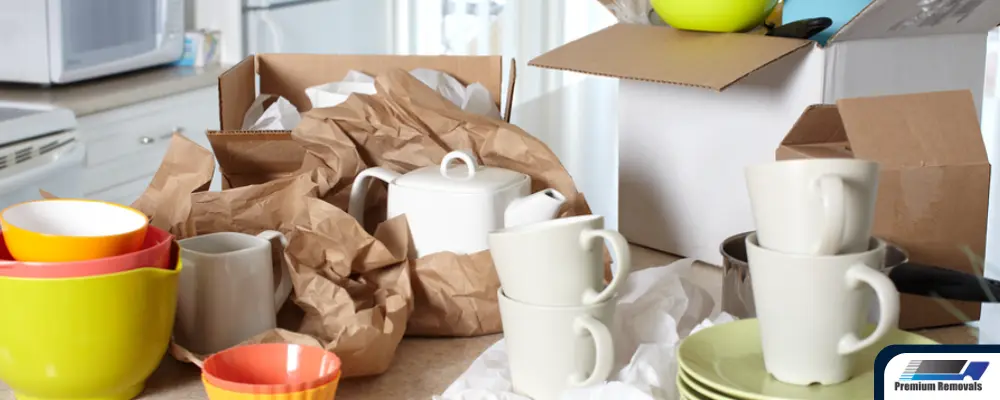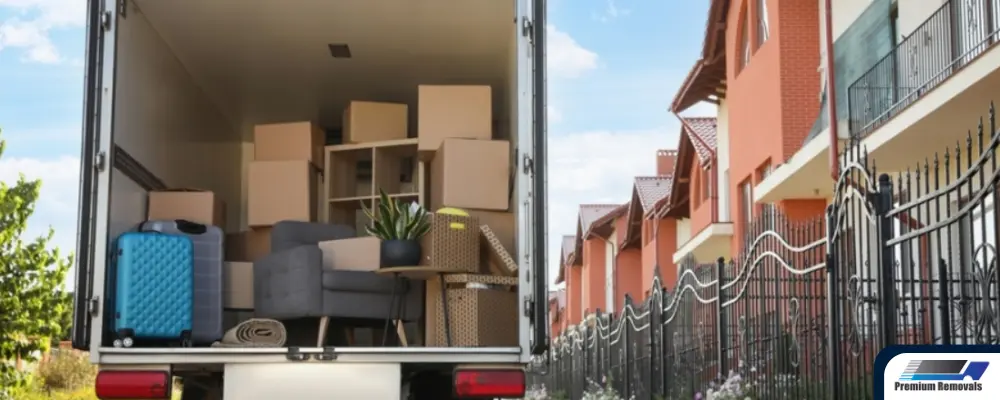Packing for a move to a new house can be stressful, but the kitchen and fragile items, as well as essential packing supplies and kitchen items, present unique challenges. Kitchens are typically filled with oddly shaped appliances, breakable dishes, and heavy cookware that require a systematic approach for careful handling by a moving company to prevent damage. Knowing how to pack your kitchen and fragile items properly is essential for ensuring a smooth and stress-free move.

In this article, we’ll walk you through the steps for packing your kitchen efficiently while protecting fragile items like glassware, dishes, and electronics. By following these tips, you can ensure your kitchen essentials arrive at your new home in one piece.
Start Early and Gather Supplies
Packing your kitchen is one of the most time-consuming tasks during a move, so it’s best to start early. Begin with non-essential items you won’t need in the days leading up to your move.
Gather the Right Supplies: To pack your kitchen and fragile items safely, you’ll need specific packing materials:
- Sturdy moving boxes in various sizes
- Specialised dish or glassware boxes with dividers
- Bubble wrap or packing paper
- Foam sheets and packing peanuts
- Strong packing tape
- Markers for labelling
It’s better to have more materials than you think you’ll need, as fragile items require extra protection. Reusable plastic tubs with lids can also be a great option for added security during transport.

Declutter and Organise
Before you start packing, take the opportunity to declutter your kitchen. Moving house is the perfect time to get rid of items you no longer use, such as old appliances, mismatched containers, or expired pantry goods.
What to Keep and What to Toss: Sort through your kitchen cabinets, drawers, and pantry to decide what’s worth taking to your new home, including essential kitchen supplies, tools, and items for each family member like paper towels. Be sure to create an inventory list of donated items, and donate usable items that you don’t need or haven’t used in a while. This process will not only lighten your load but also make packing quicker and more efficient.
Packing Non-Essential Items First
Once you’ve decluttered, start by packing non-essential items. These are the things you can live without for a few days before the move.
Non-Essential Items to Pack First:
- Decorative items like vases, wall art, and centerpieces
- Small kitchen gadgets (e.g., mixers, blenders, food processors)
- Cookbooks and recipe files
- Seasonal items, like holiday bakeware or rarely used appliances
Carefully wrap these items in bubble wrap or packing paper, especially if they’re fragile. Place heavier items at the bottom of the box and lighter items on top.
4. How to Pack Dishes, Glassware, and Fragile Items
Fragile items like dishes, glasses, and ceramic bakeware need special attention to ensure they don’t break during the move. Properly packing these items can be the difference between arriving with a full set of dishes or a box full of broken shards.
Packing Dishes and Plates:
- Line the Box with Padding: Use foam sheets or crumpled packing paper to line the bottom of the box.
- Wrap Each Dish Individually: Wrap each plate or dish in bubble wrap or several layers of packing paper. Secure with tape.
- Pack Vertically: Place plates vertically, like records, to distribute weight and reduce the risk of breakage.
- Fill Gaps: Use packing peanuts, crumpled paper, or dish towels to fill any gaps in the box to prevent shifting.
Packing Glassware:
- Use Dish or Glassware Boxes: If available, use boxes with dividers specifically designed for glasses and mugs.
- Wrap Each Glass Individually: Use bubble wrap or thick packing paper to wrap each glass, and secure it with tape.
- Place Upright: Glasses and mugs should be packed upright, never on their sides.
- Fill Gaps: Like with dishes, use packing peanuts or paper to fill any empty space in the box.
5. Packing Pots, Pans, and Cookware
Pots, pans, and larger cookware are generally durable but should still be packed carefully to avoid damage or scratches.
How to Pack Cookware:
- Stack Pots and Pans: Nest pots and pans inside one another, separating each piece with a layer of bubble wrap or paper.
- Remove Lids: Wrap lids separately with bubble wrap and pack them in a separate box, if possible. If you need to pack them together, place the lids vertically to avoid shifting.
- Secure Handles: For items with handles (e.g., frying pans), wrap the handles with extra padding to prevent them from damaging other items during transport.
6. Label Boxes Clearly
As you pack, it’s crucial to label each box clearly. This helps ensure the movers handle fragile items with care and makes unpacking much easier.
How to Label Effectively:
- Mark Fragile Boxes: Clearly label boxes containing fragile items with “Fragile” or “Handle with Care” in large, bold letters.
- Include Room Designations: Write the room the box belongs to, such as “Kitchen” or “Dining Room.” This helps movers place boxes in the correct location at your new home.
- List Key Contents: Add a brief list of key contents, such as “Plates and Bowls” or “Glassware,” so you know exactly what’s inside each box.
Should I pack fragile items in smaller boxes?
Yes, it’s often better to pack fragile items in smaller boxes. Smaller boxes help you avoid overpacking and ensure the box isn’t too heavy to carry. Fragile items are less likely to shift or break in smaller boxes because they’re more tightly packed.
7. Safely Packing Small Appliances
Small kitchen appliances like blenders, toasters, and coffee machines require careful handling during a move. These items often have delicate parts and can easily get damaged if not packed properly.
How to Pack Small Appliances:
- Unplug and Clean: Ensure all appliances are clean and dry before packing.
- Disassemble Removable Parts: Take apart any removable parts, such as blades, trays, or lids, and pack them separately.
- Wrap the Appliance: Wrap each appliance in bubble wrap or packing paper to protect it from damage.
- Use the Original Box: If you still have the original packaging, use it, as it’s designed to protect the appliance during transport. If not, pack the appliance snugly in a moving box with plenty of padding.
8. Packing Liquids and Pantry Items
When moving pantry items, be selective about what you bring. Expired items and half-used bottles are often not worth the trouble of moving.
Packing Liquids:
- Seal Bottles: Tape the lids of bottles and jars to prevent leaks during transport.
- Use Plastic Bags: Place liquids in sealable plastic bags to contain any spills in case the bottle breaks or leaks.
- Pack Upright: Always pack liquids upright and ensure they are well-cushioned to prevent tipping during the move.
Packing Dry Goods:
- Check Expiration Dates: Discard any expired food before packing.
- Use Resealable Bags: For open packets or boxes of food, transfer them to resealable bags to prevent spills.
- Pack in Sturdy Boxes: Use strong boxes to pack heavy pantry items like canned goods, and make sure they are balanced to avoid tipping.
9. Packing your Kitchen Knives and Utensils
Packing sharp objects like knives requires extra care to avoid injuries during the move.
How to Pack Knives:
- Wrap Each Knife Separately: Use bubble wrap, towels, or cardboard sleeves to wrap each knife securely.
- Secure the Bundle: Once wrapped, bundle the knives together and tape them securely to prevent them from coming apart.
- Label Clearly: Label the box or bundle with “Sharp” or “Knives” to avoid accidents during unpacking.
Packing Utensils:
- Bundle Utensils: Wrap utensils like spatulas, tongs, and whisks together and pack them in small boxes or drawers.
- Use Ziplock Bags for Small Items: Keep small items like measuring spoons and corkscrews together in labelled ziplock bags for easy unpacking.
10. Hire Professional Help if Needed
If packing your kitchen and fragile items feels overwhelming, consider hiring professional packing services. Removalists with experience in handling fragile items can pack your kitchen efficiently and with the right materials, ensuring everything arrives safely at your new home.

Professional packers have the knowledge and tools to secure even the most delicate items, and their expertise can save you time and stress.
Frequently Asked Questions
How do I safely pack kitchen knives to avoid injury?
Wrap each knife individually in bubble wrap or cardboard, then bundle them together and tape securely. Place the bundle in a labelled box, ensuring the blades are protected. Always label the box as containing sharp objects to avoid accidents during unpacking.
Can I leave items in drawers when moving kitchen furniture?
It’s not recommended to leave items in drawers during a move. The weight of the items can damage the furniture, and the contents may shift, causing breakage or injury. Empty drawers and pack the contents in boxes for safety.
What’s the best way to pack breakable glassware?
Wrap each glass individually in bubble wrap or packing paper, then place them upright in a sturdy box. Use a dish or glassware box with dividers, and fill any gaps with packing paper or foam peanuts to prevent shifting.
How far in advance should I start packing my kitchen?
It’s ideal to start packing your kitchen about two weeks before your move. Begin with non-essential items and pack the items you use daily, such as cookware and utensils, a few days before moving day.
Conclusion
Packing your kitchen and fragile items doesn’t have to be a stressful experience. By starting early and giving yourself plenty of time, gathering the right materials, including protective materials like rolled up tea towels, and following the steps outlined in this guide, you can ensure that your kitchen essentials, including slow cookers and fragile food items, are packed safely and securely. With careful organisation and a little extra attention to delicate items, your kitchen will be ready for the big move, and you’ll have peace of mind knowing your belongings are well-protected.
